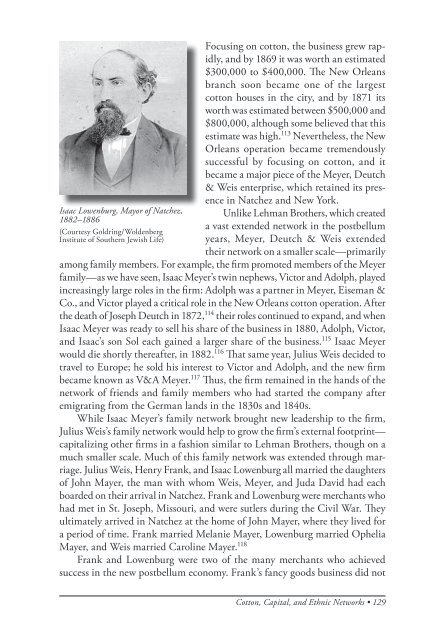American Jewish Archives Journal, Volume 64, Numbers 1 & 2
American Jewish Archives Journal, Volume 64, Numbers 1 & 2
American Jewish Archives Journal, Volume 64, Numbers 1 & 2
Create successful ePaper yourself
Turn your PDF publications into a flip-book with our unique Google optimized e-Paper software.
Isaac Lowenburg, Mayor of Natchez,<br />
1882–1886<br />
(Courtesy Goldring/Woldenberg<br />
Institute of Southern <strong>Jewish</strong> Life)<br />
Focusing on cotton, the business grew rapidly,<br />
and by 1869 it was worth an estimated<br />
$300,000 to $400,000. The New Orleans<br />
branch soon became one of the largest<br />
cotton houses in the city, and by 1871 its<br />
worth was estimated between $500,000 and<br />
$800,000, although some believed that this<br />
estimate was high. 113 Nevertheless, the New<br />
Orleans operation became tremendously<br />
successful by focusing on cotton, and it<br />
became a major piece of the Meyer, Deutch<br />
& Weis enterprise, which retained its presence<br />
in Natchez and New York.<br />
Unlike Lehman Brothers, which created<br />
a vast extended network in the postbellum<br />
years, Meyer, Deutch & Weis extended<br />
their network on a smaller scale—primarily<br />
among family members. For example, the firm promoted members of the Meyer<br />
family—as we have seen, Isaac Meyer’s twin nephews, Victor and Adolph, played<br />
increasingly large roles in the firm: Adolph was a partner in Meyer, Eiseman &<br />
Co., and Victor played a critical role in the New Orleans cotton operation. After<br />
the death of Joseph Deutch in 1872, 114 their roles continued to expand, and when<br />
Isaac Meyer was ready to sell his share of the business in 1880, Adolph, Victor,<br />
and Isaac’s son Sol each gained a larger share of the business. 115 Isaac Meyer<br />
would die shortly thereafter, in 1882. 116 That same year, Julius Weis decided to<br />
travel to Europe; he sold his interest to Victor and Adolph, and the new firm<br />
became known as V&A Meyer. 117 Thus, the firm remained in the hands of the<br />
network of friends and family members who had started the company after<br />
emigrating from the German lands in the 1830s and 1840s.<br />
While Isaac Meyer’s family network brought new leadership to the firm,<br />
Julius Weis’s family network would help to grow the firm’s external footprint—<br />
capitalizing other firms in a fashion similar to Lehman Brothers, though on a<br />
much smaller scale. Much of this family network was extended through marriage.<br />
Julius Weis, Henry Frank, and Isaac Lowenburg all married the daughters<br />
of John Mayer, the man with whom Weis, Meyer, and Juda David had each<br />
boarded on their arrival in Natchez. Frank and Lowenburg were merchants who<br />
had met in St. Joseph, Missouri, and were sutlers during the Civil War. They<br />
ultimately arrived in Natchez at the home of John Mayer, where they lived for<br />
a period of time. Frank married Melanie Mayer, Lowenburg married Ophelia<br />
Mayer, and Weis married Caroline Mayer. 118<br />
Frank and Lowenburg were two of the many merchants who achieved<br />
success in the new postbellum economy. Frank’s fancy goods business did not<br />
Cotton, Capital, and Ethnic Networks • 129
















